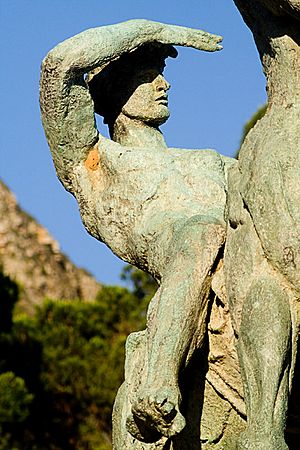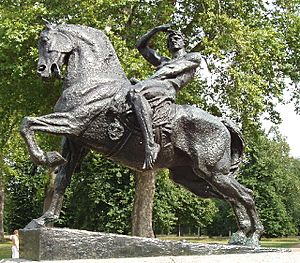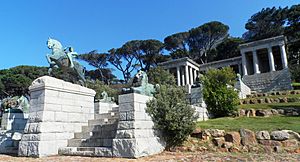Physical Energy (sculpture) facts for kids


Physical Energy is a famous bronze statue of a person riding a horse. It was created by an English artist named George Frederic Watts. Watts was mostly known for his paintings, but he also started making sculptures in the 1870s.
The first full-size version of Physical Energy was made in 1902. This was just two years before Watts passed away. He wanted the statue to be a way to remember "unknown worth." Watts said it showed a "restless physical impulse." This means it represents the constant human drive to achieve new things.
The first model of the statue, made of plaster, is kept at the Watts Gallery. There are four large bronze copies of the statue. You can find them in London, Cape Town, and Harare. Another one will soon be placed at the Watts Gallery in Compton, Surrey. Smaller bronze copies were also made after Watts died.
Contents
Creating the Statue
Watts started working on Physical Energy in the early 1880s. The idea for this statue came from an earlier large horse statue he made. That one was of Hugh Lupus, the 1st Earl of Chester. Watts finished that statue in 1883-1884. It was displayed at Eaton Hall, Cheshire. That earlier statue was inspired by parts of the ancient Greek sculptures known as the Elgin Marbles.
The original model for Physical Energy was very big and heavy. It weighed about 3.5 tons and was made from plaster mixed with glue. This model is now at the Watts Gallery in Compton. Watts had help from George Thompson and Louis Deuchars to create it.
Watts believed that great art could help people and the country. He saw Physical Energy as a symbol of human strength. It also showed humanity's never-ending effort to improve.
Watts took a long time to finish the statue. Even though his friend John Everett Millais encouraged him, Watts kept changing the plaster model. The first full-size bronze copy was finally made in 1902.
Where to Find the Statues
There are several full-size bronze copies of Physical Energy around the world. Each one has its own interesting story.
First Bronze Cast: Cape Town
The very first full-size bronze copy was made in 1902. It was cast at the Parlanti Foundry in Fulham, London. People said it was the biggest bronze statue ever made in Britain at that time. Watts gave this statue to the British Government.
In 1904, the year Watts died, the statue was shown at the Royal Academy Summer Exhibition. It was first suggested that the statue be placed where Cecil Rhodes was buried. But this was too difficult to do. So, it was instead put at the Rhodes Memorial in Cape Town, South Africa. This memorial is on Devil's Peak.
Second Bronze Cast: London
A second large copy was made in 1905. This one was meant to be a gift to the British nation. It was cast at A.B. Burton's Thames Ditton Foundry in London. This copy was even more detailed and weighed 6 tons. It took 18 months to create.
In September 1907, it was placed in London's Kensington Gardens. You can find it overlooking the north-west side of the Serpentine lake.
Third Bronze Cast: Harare
A third full-size bronze copy was made in 1959. This one was cast from the same plaster model used for the second statue. It has some small differences, like the horse's rein being on the right side.
The British South Africa Company arranged for this statue to be made. It was first placed in front of the High Court in Lusaka, Zambia. Later, it was moved to a racecourse in Salisbury, Southern Rhodesia. Today, this city is called Harare, in Zimbabwe. Since 1981, it has been in the grounds of the National Archives in Harare.
Fourth Bronze Cast: Watts Gallery
A fourth full-size bronze copy was ordered by the Watts Gallery. This was to celebrate 200 years since Watts was born. It was cast in 2017 using a new mold from the original plaster model.
This statue was shown at the Royal Academy in 2017-18. It will soon be permanently placed at the Watts Gallery – Artists’ Village.
Smaller Copies
Many smaller bronze versions of Physical Energy were made and sold after Watts died. One of these was shown at the Royal Academy in 1904. Another one, made by Watts's assistant Thomas Wren in 1914, was sold for a good price in 2014.
You can also see smaller copies at the Watts Gallery, the Laing Art Gallery in Newcastle, and the Walker Art Gallery in Liverpool.
In 1960, a silver copy of the statue was given to the Queen Mother. This was at the unveiling of the Lusaka statue.
Other Uses of the Statue's Image
The image of the Physical Energy statue is used in different ways. It is the logo for the Watts Gallery – Artists’ Village. It is also part of the logo for Rhodes University and appears on its crest.
In the 1920s, a company called Labour Publishing Company Ltd used an image of Physical Energy. In the 1930s, the statue's image was also used as a trademark for products like Energen Rolls.
The statue also inspired a piece of music. The composer Charles Villiers Stanford wrote his Sixth Symphony in memory of Watts, inspired by Physical Energy.


